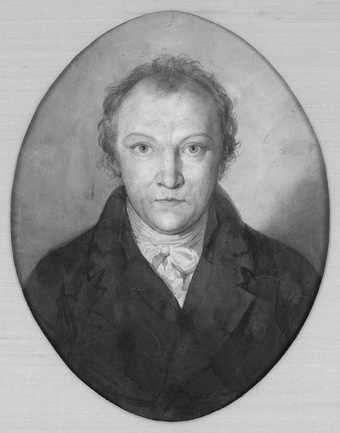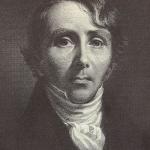I give you the end of a golden string;
Only wind it into a ball,
It will lead you in at Heaven’s gate,
Built in Jerusalem’s wall.
William Blake was born on this day, the 28th of November in 1757, in Soho, in Westminster, in London.
His family were Dissenters and his whole life he would follow his own spiritual lights, but nonetheless William was baptized into the Anglican church. His formal education was brief, instead he was educated at home by his mother Catherine. It’s hard to tell but it appears his father James, a hosier, while by all accounts was of modest means still purchased prints and illustrated books, for young William to copy. At fifteen he was apprenticed as an engraver.
In advancing his studies Blake was sent to copy images from churches around London. While working at Westminster Abbey, he had several visions of Jesus and the apostles, as well as a procession of chanting monks and priests. He would experience visions for the whole of his life. He felt much of his inspiration came directly from the visitations of archangels. Later the poet William Wordsworth would say, “There was no doubt that this poor man was mad, but there is something in the madness of this man which interests me more than the sanity of Lord Byron and Walter Scott”
At the end of his apprenticeship, Blake continued his studies at the Royal academy. There he developed an enmity for the school’s president Joshua Reynolds. And here he began to develop his own theories of art.
In 1781 he married Catherine Boucher in an Anglican church. She was illiterate, and he taught her to read and write. At the same time he trained her as an engraver. She also worked as a colorist.
Two years later he published his first collection of poems, Poetical Sketches. In 1793 his Visions of the Daughters of Albion argued for women’s rights. He would continue, publishing in addition to illustrating other people’s books, some thirty of his own.
In 1803 Blake was charged with sedition, yelling “Damn the king, the soldiers are all slaves!” He was cleared at trial, but his radical sympathies were noted. While not associated with any party he carried a resentment against unearned wealth, and wars perpetrated in support of empire. Later Marxists and Anarchists both claim him as a spiritual forebearer.
In 1804 he began his masterwork Jerusalem, a project that would occupy the next sixteen years.
It’s hard to define William Blake’s spirituality. G. E. Bentley writing for the Brittanica, tried:
“Blake was christened, married, and buried by the rites of the Church of England, but his creed was likely to outrage the orthodox. In “A Vision of the Last Judgment” he wrote that “the Creator of this World is a very Cruel Being,” whom Blake called variously Nobodaddy and Urizen, and in his emblem book For the Sexes: The Gates of Paradise, he addressed Satan as “The Accuser who is The God of This World.” To Robinson “He warmly declared that all he knew is in the Bible. But he understands the Bible in its spiritual sense.” Blake’s religious singularity is demonstrated in his poem “The Everlasting Gospel” (c. 1818):
“The Vision of Christ that thou dost See
Is my Visions Greatest Enemy
Both read the Bible day & night
But thou readst black where I read White.
“But some of the orthodox not only tolerated but also encouraged Blake. Two of his most important patrons, the Rev. A.S. Mathew and the Rev. Joseph Thomas, were clergymen of the Church of England.
“Blake was a religious seeker but not a joiner. He was profoundly influenced by some of the ideas of Swedish theologian Emanuel Swedenborg, and in April 1789 he attended the general conference of the New Church (which had been recently founded by followers of Swedenborg) in London. Blake’s poem “The Divine Image” (from Songs of Innocence) is implicitly Swedenborgian, and he said that he based his design called The Spiritual Preceptor (1809) on the theologian’s book True Christian Religion. He soon decided, however, that Swedenborg was a “Spiritual Predestinarian,” as he wrote in his copy of Swedenborg’s Wisdom of Angels Concerning the Divine Providence (1790), and that the New Church was as subject to “Priestcraft” as the Church of England.
“Blake loved the world of the spirit and abominated institutionalized religion, especially when it was allied with government…”
Blake espoused a kind of nonduality. Much of what he presents has a gnostic feel to it, if one’s gnosticism does not reject physicality, and sexuality. Still there is a lostness and a calling to a source, the many returning to the one. There’s also Hinduism, at least the Hinduism of the Bhagavad Gita, which Blake read in an early English translation. Shikha Shukla writes:
“Of the entire all the romantic poets, Blake is the most independent and original. Though the most extraordinary literary genius of his age, he had practically no influence upon it. He was guided by his own intuition for which all nature was a vast mystical spiritual symbolism. As a child he has visions of God and the angels and under the spells of such transcendental mysticism he saw strange , elves fairies and devils –he had the illusion that he received visits from the souls of the great dead, Moses, Virgil, Homer, Dante, Milton – ‘majestic shadows, gray but luminous,’ he calls them. Naturally a man of such mystical and unworldly
temperament, the spiritualistic essence of Hindu philosophy had a great fascination and appeal, therefore, Northrop Frye correctly observes in his study of William Blake entitled `fearful symmetry,’ ‘Blake was among the first of the European idealist able to link his own tradition of thought with the Bhagwad Gita.‘”
Buddhists certainly like him. Mark Ferrar writing in the Journal of Chinese Philosophy tells us The similarities between William Blake’s philosophical system and that of Buddhism (particularly the Ch’an(a) or Zen School) are no less than astonishing. One is struck by a fundamental similitude underlying the teaching of the Ch’an school and that of Blake’s radical epistemology.”
Of course no one has to go further than Auguries of Innocence to see why Buddhists might have this view.
To see a World in a Grain of Sand
And a heaven in a Wild Flower,
Hold Infinity in the palm of your hand
And Eternity in an hour.
On the 12th of August 1827, Blake stopped his paid work, drew a sketch of his wife, promised he would be with her forever, and then early that evening died. One biographer said a lodger in the Blake house said, “I have been at the death, not of a man, but of a blessed angel.”
While he remained a nonconformist for his life, he was baptized and married within the Church of England. And, he was buried from the Church as well. Although his remains were interred in a Nonconformist graveyard.
Catherine reported that Blake continued to visit with her up until her own death in 1831.














